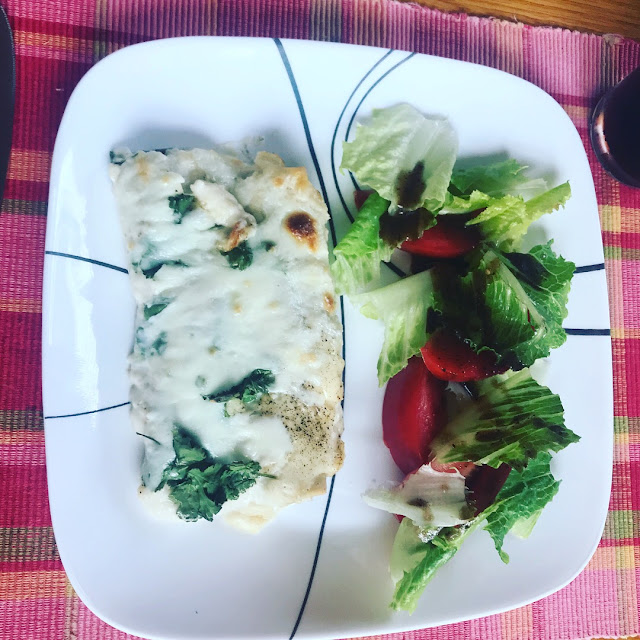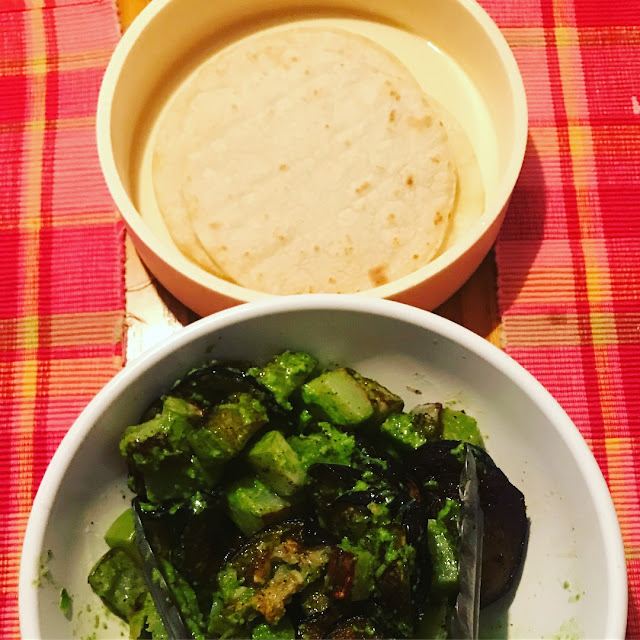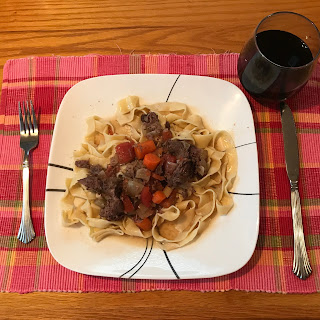The Personal Chef Life: Week of Beef Cheeks
I am still trying to get to writing some more thought pieces and creative writing bits to premiere on the blog, but since paid work has my first priority, I can always keep the food posts going. These are much faster and easier to turn around. So while the cats sleep through the thunderstorm, I will crank out another this week in the personal chef life piece.
Beef cheeks are fairly easy to find down here, because they are used in dishes like barbacoa, which means jackpot for me making some of my favorite beef dishes and expanding to new ones. For this first go round on beef cheeks, I stuck to my more traditional flavor profiles, which is not exactly grandma's traditional. I have been told that she did not use any garlic, but I use it like crazy in everything I can. If you can get the cheeks pre-trimmed, it will save you some work because these are literally the cheeks, so there is a lot of connective tissue around the muscle and a lot of fat. Although I cooked it all, I trimmed the cheeks first and separated the scraps before serving.
I had initially planned to make the cheeks Sunday, and break up the week of beef with chayote tacos Monday, but the cheeks were delayed until Monday. The chayote tacos were delicious on Sunday instead. Like the watermelon rind curry, the roasted chayote is a dish I would like to make more often. It was simple, fresh, and rich and light at the same time.
Along with the beef cheeks, I also made four eggs worth of fresh pasta dough on Monday. I used the same recipe as I had used for the agnolotti, which will be my go to until I have a scale and can be more scientific and weight out the ingredients properly. The last three days have been some new combination of a pasta and the beef cheeks.
When we did chuck roast, my Dad would usually ad about 3/4-1 cup of port of whatever wine was on hand and make up the rest of the liquid with a cup of water. A lot of beef cheeks recipes have you add beef stock, but it really was not necessary. I used 3/4 cup of a dry red wine and 3 cups of 1% milk, because that needed to be used. At the end of 6 hours, you just have an amber broth because all the milk solids get transformed by the process.
For Beef Cheeks Day 1, I made some of the pasta dough into tagliatelle width pasta (~1/4" strips when raw). This was the first time I have had the pasta dough on its own rather than stuffed, and it was really good. My sister thought that I had added butter, but that was just the natural richness of the eggs and the olive oil I tossed it in. After removing and reserving the trimmings, I shredded the meat and served it with the veggies over the pasta.
For Beef Cheeks Day 2, I picked through the reserved trimmings for the protein parts. Once I separated what I could form the fat, I added extra from the leftover and a bit of the veggies and cooked it with some fresh onion, a seeded jalapeño, and added green pepper when the onion was translucent. I also added a few tablespoons of the wine remaining for Monday night dinner. That was rolled into fresh pasta dough cannelloni style and topped with béchamel sauce, cilantro, and some mild queso to make a flavor more reminiscent of steak and cheese than anything actually Italian. It ended up working really well. By not making the béchamel into a full on cheese sauce, it was not overly rich. All the flavors blended in when it baked in the oven.
Finally for Beef Cheeks Day 3, I had toasted the remaining pasta and scraps when I had the oven on for the cannelloni. I cooked it and we had some reheated leftovers on top. Toasted pasta is excellent, but do not be afraid to let it cook all the way through. You want it to get fully tender, and it will hold together.
There is still some leftover to enjoy, but this is the extent of the triptych of variations I had planned out for the week. The full recipe of what I did follows a brief description of the chayote and eggplant tacos.
Until the next (most likely food) post:
Living large on a budget with beef cheeks slow braised in a crock pot and served over fresh pasta or the carb of your choice.
Ingredients:
Slow Braised Beef Cheeks in Milk and Wine
This week I made beef cheeks. This lovely less expensive cut of beef is affordable compared to my usual stewing meat - chuck - which was my Dad's go to for an inexpensive beef meal. When my sister and I were younger, we would go to Mass with Dad and then stop at the store for the groceries for Sunday dinner and lunches for the week. One dish on regular rotation was my grandmother's chuck roast recipe, which I still like to make. There is nothing I like more than leftovers that taste better than when you first make a dish, and that is what you get with slow roasted beef.Beef cheeks are fairly easy to find down here, because they are used in dishes like barbacoa, which means jackpot for me making some of my favorite beef dishes and expanding to new ones. For this first go round on beef cheeks, I stuck to my more traditional flavor profiles, which is not exactly grandma's traditional. I have been told that she did not use any garlic, but I use it like crazy in everything I can. If you can get the cheeks pre-trimmed, it will save you some work because these are literally the cheeks, so there is a lot of connective tissue around the muscle and a lot of fat. Although I cooked it all, I trimmed the cheeks first and separated the scraps before serving.
I had initially planned to make the cheeks Sunday, and break up the week of beef with chayote tacos Monday, but the cheeks were delayed until Monday. The chayote tacos were delicious on Sunday instead. Like the watermelon rind curry, the roasted chayote is a dish I would like to make more often. It was simple, fresh, and rich and light at the same time.
Along with the beef cheeks, I also made four eggs worth of fresh pasta dough on Monday. I used the same recipe as I had used for the agnolotti, which will be my go to until I have a scale and can be more scientific and weight out the ingredients properly. The last three days have been some new combination of a pasta and the beef cheeks.
Preparing the Beef Cheeks
After looking at a bunch or recipes, I ended up doing something more how I do chuck roast for the flavor profile with some additions. The end result was full of flavor with an unctuous rich texture from the melting of the meat in the milk broth.When we did chuck roast, my Dad would usually ad about 3/4-1 cup of port of whatever wine was on hand and make up the rest of the liquid with a cup of water. A lot of beef cheeks recipes have you add beef stock, but it really was not necessary. I used 3/4 cup of a dry red wine and 3 cups of 1% milk, because that needed to be used. At the end of 6 hours, you just have an amber broth because all the milk solids get transformed by the process.
For Beef Cheeks Day 1, I made some of the pasta dough into tagliatelle width pasta (~1/4" strips when raw). This was the first time I have had the pasta dough on its own rather than stuffed, and it was really good. My sister thought that I had added butter, but that was just the natural richness of the eggs and the olive oil I tossed it in. After removing and reserving the trimmings, I shredded the meat and served it with the veggies over the pasta.
 |
| I was worried that I forgot about getting cheese to top it with. It did not need it at all. |
 |
| Not Enchiladas; just slightly confused cannelloni. |
 |
| Took this picture a little too fast, but it was better plating than my other one. |
 |
| Leftover perfection! |
Almost Rick Bayless's Chayote Tacos
Like a lot of recipes, I had to modify based on what I have on hand, but we have most of what I needed to make these chayote based vegetable tacos from Rick Bayless. I added fresh green peppers in for the parsley and used a jalapeño instead of serrano for the sauce. I only had two chayote gourds, so I roasted an eggplant in slices instead of adding cheese. It was the bomb you could not stop eating. I have been using the extra green chili sauce on my breakfast. The roasted chayote has a texture and taste some where in between a potato and a water chestnut.Until the next (most likely food) post:
Living large on a budget with beef cheeks slow braised in a crock pot and served over fresh pasta or the carb of your choice.
Ingredients:
- 3/4 red wine
- 3 cups milk
- 3 tomatoes - peeled and diced
- 2-3 cups rough chopped celery
- 2 onions diced
- 3-4 large whole carrots diced
- 4-5 smallish cloves fresh garlic peeled
- 2-3 bay leaves if they are small
- salt
- pepper
- dried rosemary to taste
- 1 large beef cheek
- ~7 quart crock pot
Instructions:
- Prepare all vegetables as described in the ingredients list. You want pieces that are 1/4-1/2" in size. Salt the diced tomatoes.
- If you got untrimmed beef cheeks like how mine came, trim off the fat and any tough looking connective tissue. Reserve.
- Salt and pepper the cheeks. Render off a bit of fat from the trimmings, and then brown the meat on all sides.
- In the bottom of the crock pot I put in the carrots, celery, garlic, and onion with salt, pepper, and rosemary. I gave it a stir then topped it with bay leaves before adding the meat.
- I layered the trimmed cheeks in the middle over the bay leaves and put all the trimmings around the outside.
- After I added the meat I put the tomatoes on top and added the milk and wine over the top. This did not cover the meat at all, but I did not want to do that because the vegetables would be releasing liquid, and I prefer meat that is not waterlogged when it has been slow cooked.
- Leave covered with a lid on high for 6 hours. The meat will slowly sink down into the broth, but not fully submerge. That is exactly what you want.
- When you hit 6 hours without removing the lid, it will be perfect. Take out all the trimming pieces and reserve if you plan to pick out the meat later. Roughly shred the cheeks remaining in the pot if desired to help divide up servings.








Comments
Post a Comment